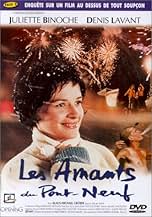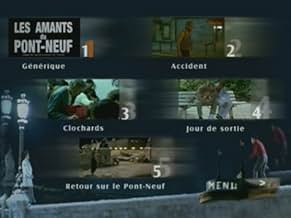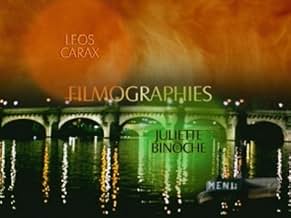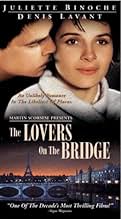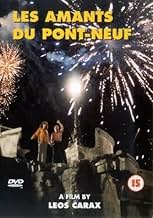CALIFICACIÓN DE IMDb
7.6/10
16 k
TU CALIFICACIÓN
Alex, que no tiene hogar y es adicta al alcohol, y Michèle, que está perdiendo la vista, forman una relación mientras duermen a la intemperie en el puente Pont-Neuf de París.Alex, que no tiene hogar y es adicta al alcohol, y Michèle, que está perdiendo la vista, forman una relación mientras duermen a la intemperie en el puente Pont-Neuf de París.Alex, que no tiene hogar y es adicta al alcohol, y Michèle, que está perdiendo la vista, forman una relación mientras duermen a la intemperie en el puente Pont-Neuf de París.
- Nominada a1 premio BAFTA
- 4 premios ganados y 8 nominaciones en total
Chrichan Larsson
- Julien
- (as Chrichan Larson)
- Dirección
- Guionista
- Todo el elenco y el equipo
- Producción, taquilla y más en IMDbPro
Opiniones destacadas
I've just watched this film and, out of curiosity, the comments of several contributors to this bulletin board. Simply can't fathom the glowing enthusiasm of most of these - though I suppose they are self-selected from those who have actually been able to sit through it.To me it seemed phony, pretentious, and in the end unbelievably boring - both words here seem applicable alone as well as in tandem. I'm rather fond of Binoche, and this may have something to do with my impression that she found the role one that couldn't be played convincingly - that she as a result could only stumble through it sans conviction. Why did I then watch it through? In the hope of some saving grace - which I certainly failed to find in that silly resolution.
Of the four feature films from French writer-director Leos Carax, 1991 "Les Amants du Pont-Neuf" is the most hopeful and happy (mind you it's not the generic definition of 'happy' per se), still a story of love, an extraordinary loving relationship maturing through time and fateful instances as the film progresses. You might even agree afterall, that the whole journey of experience is rather satisfying. Director Leos Carax once again demonstrated a feast of his talented visual eye: things, faces, scenes, close-ups, aerial or simple wide shots, are composed, captured within the frames, graphically presented. He optimized the use of colors and movements: a fete of lights and fireworks celebrations, dazzling fire-eating shows, caressing shots of waves in motion of zigzagging speed boat and water-skiing.
Carax sure didn't water down any sentiments - he used bold strokes with no apology: his intro showed us the 'unpleasant' side of Paris, the dream city of Europe has homeless and sights of street people, too. Binoche, as always, dependably delivered an intense portrayal of this artist, Michele, on the verge of going blind (note the ending credits roll indicating the paintings were done by Juliette Binoche herself), and as the story unfolds, has a past mesmerizingly mysterious to Lavant's Alex character.
Again captured on film is Denis Lavant's legs a-moving within a frame running, dancing. Reminiscent of Truffaut and Jean-Pierre Leaud's Antoine filmic partnership - Lavant is Alex in three of Carax' endeavors: "Boy Meets Girl" 1984; "Bad Blood" 1986; and here in "The Lovers on the Bridge." (To see Denis Lavant away from his 'boyish' roles, try French director Claire Denis' 1999 "Beau Travail" - another intense delivery, and we actually get to see more of Lavant's solo legwork a-dancing.)
Yes, it's quite an ambitious film. Carax packed a lot of layers of emotions, spins and details, along with stunning visual angles and photographic magic in this one story. He is truly a passionate filmmaker and dramatic writer. Binoche and Lavant performed terrifically well together, and the third character, Klaus Michael Gruber as Hans the homeless senior also with a mysterious past, added accents with his performance. The sequence towards the end, first you get the telling of a joke with hearty laughter, then the fateful phrase of "ce soir c'est le soir", to the underwater sequence and what follows - Carax would not let up with any moment for you, the audience, to breathe after laughs and gasps. Choreographed magic? Yes. Go see it for yourself. Hang in there with the pair and you will not be disappointed. Have an open mind and you'll enjoy it.
Carax sure didn't water down any sentiments - he used bold strokes with no apology: his intro showed us the 'unpleasant' side of Paris, the dream city of Europe has homeless and sights of street people, too. Binoche, as always, dependably delivered an intense portrayal of this artist, Michele, on the verge of going blind (note the ending credits roll indicating the paintings were done by Juliette Binoche herself), and as the story unfolds, has a past mesmerizingly mysterious to Lavant's Alex character.
Again captured on film is Denis Lavant's legs a-moving within a frame running, dancing. Reminiscent of Truffaut and Jean-Pierre Leaud's Antoine filmic partnership - Lavant is Alex in three of Carax' endeavors: "Boy Meets Girl" 1984; "Bad Blood" 1986; and here in "The Lovers on the Bridge." (To see Denis Lavant away from his 'boyish' roles, try French director Claire Denis' 1999 "Beau Travail" - another intense delivery, and we actually get to see more of Lavant's solo legwork a-dancing.)
Yes, it's quite an ambitious film. Carax packed a lot of layers of emotions, spins and details, along with stunning visual angles and photographic magic in this one story. He is truly a passionate filmmaker and dramatic writer. Binoche and Lavant performed terrifically well together, and the third character, Klaus Michael Gruber as Hans the homeless senior also with a mysterious past, added accents with his performance. The sequence towards the end, first you get the telling of a joke with hearty laughter, then the fateful phrase of "ce soir c'est le soir", to the underwater sequence and what follows - Carax would not let up with any moment for you, the audience, to breathe after laughs and gasps. Choreographed magic? Yes. Go see it for yourself. Hang in there with the pair and you will not be disappointed. Have an open mind and you'll enjoy it.
This is one of the great romances precisely because it goes against the grain of all the great screen romances. Because of its ability to strike new terrain -- to go where no romance has gone before, to take chances, in essence -- it achieves a level of passionate intensity that most romantic films could only dream of mustering.
The camera work -- by Jean-Yves Escoffier, one of the great cinematographers working today (who shot Leos Carax's early films -- "Bad Blood" and "Boy Meets Girl" -- as well as Larry Clark's "Kids," and the directorial debut of Harmony Korine, "Gummo") -- is absolutely breathtaking. I cannot overemphasize this. It is, perhaps, one of the most beautiful color films ever made. The style of the film suits the subject matter perfectly. It proves that the great films have a form that not only compliments the subject matter, but becomes it. The content is the form, and vise versa. The film is shot "Cinema-Verite" style, with rough, hand-held, choppy camerawork, and a gritty, realistic aesthetic quality. There are moments of fancy and surrealism that would seem to utterly contradict this style. On the contrary, these moments are rendered believable, avoid presenting problems of logic, because of the film's harsh, balancing tone. The "wild" style of the film captures perfectly the passionate, stormy affair of the lovers -- the truest love, and certainly the most passionate, the film says, is that closest to nature, to the base element of humanity.
Another layer of enjoyment comes from the film's similarity to Jean Vigo's "L'Atlante." In fact, the final sequence in the film has the two lovers plummeting from the bridge into the cold water. They are picked up by a sand barge, on its final trip to the ocean. The husband and wife, who we learn have spent their life shipping sand, agree to take them along. It is almost as if the couple in "L'Atlante" have reappeared to prove that passionate, tumultuous love affairs can end happily, despite their problems. One of the last shots of the film shows the two lovers walking across the barge, over the hills of sand, to the bow -- a direct quotation of "L'Atlante."
The last shot (for enemies of James Cameron's "Titanic" -- an absolutely shallow romance; as cold and heartless as the iceberg that dooms the ship) shows the two lovers hovering over the bow of the ship, magically, as if suspended by love. It is obvious James Cameron plagiarized this moment ("Les Amants..." came out in 1991). This fact should be trumpeted far and wide. "Titanic" is a bloated whale of a movie. "Les Amants du Pont Neuf" is simply the greatest romance to have erupted on the screens in the last decade.
The camera work -- by Jean-Yves Escoffier, one of the great cinematographers working today (who shot Leos Carax's early films -- "Bad Blood" and "Boy Meets Girl" -- as well as Larry Clark's "Kids," and the directorial debut of Harmony Korine, "Gummo") -- is absolutely breathtaking. I cannot overemphasize this. It is, perhaps, one of the most beautiful color films ever made. The style of the film suits the subject matter perfectly. It proves that the great films have a form that not only compliments the subject matter, but becomes it. The content is the form, and vise versa. The film is shot "Cinema-Verite" style, with rough, hand-held, choppy camerawork, and a gritty, realistic aesthetic quality. There are moments of fancy and surrealism that would seem to utterly contradict this style. On the contrary, these moments are rendered believable, avoid presenting problems of logic, because of the film's harsh, balancing tone. The "wild" style of the film captures perfectly the passionate, stormy affair of the lovers -- the truest love, and certainly the most passionate, the film says, is that closest to nature, to the base element of humanity.
Another layer of enjoyment comes from the film's similarity to Jean Vigo's "L'Atlante." In fact, the final sequence in the film has the two lovers plummeting from the bridge into the cold water. They are picked up by a sand barge, on its final trip to the ocean. The husband and wife, who we learn have spent their life shipping sand, agree to take them along. It is almost as if the couple in "L'Atlante" have reappeared to prove that passionate, tumultuous love affairs can end happily, despite their problems. One of the last shots of the film shows the two lovers walking across the barge, over the hills of sand, to the bow -- a direct quotation of "L'Atlante."
The last shot (for enemies of James Cameron's "Titanic" -- an absolutely shallow romance; as cold and heartless as the iceberg that dooms the ship) shows the two lovers hovering over the bow of the ship, magically, as if suspended by love. It is obvious James Cameron plagiarized this moment ("Les Amants..." came out in 1991). This fact should be trumpeted far and wide. "Titanic" is a bloated whale of a movie. "Les Amants du Pont Neuf" is simply the greatest romance to have erupted on the screens in the last decade.
Oh, please. I used to say I could watch Juliette Binoche read the phone book, but this sorely tested that theory. What a mess of a movie! -- by turns a tired liberal pseudodocumentary on the homeless (though by the end, you realize that according to this flick, homelessness is a byproduct of personal misfortune and not, evidently, any societal forces), a down-and-dirty romance (Binoche can be forgiven; what actress [or actor] wouldn't want to play a one-eyed homeless artist losing the vision in the other eye?), an extended music video, and God knows what else, all set in a Paris largely devoid of traffic and people. Completely lacking *internal* logic (and yes, fables do need that), it seems to have acquired quite a few devotees drawn to its alleged "poetry." All I see is pretentiousness and self-indulgence. If the other reviews here tempt you to see it anyway, that's fine; but don't say you weren't warned.
10rnadiv
There's a lot to say here about the performances of Juliette Binoche and Denis Lavant. Lavant is always good in Carax's films; here he is simply outstanding. And seeing Binoche play a character with dimension, for once, is a pleasure. The real surprise is Klaus-Michael Gruber whose Hans is perhaps the most believable aspect of the film.
But what draws me to this film--tied for best of what I've seen Carax do, along with "Mauvais Sang"--is the photography, sound and editing. Carax understands the use of image in narrative, and how to bring discordant scenes together to provide the sense of desperation needed to make this love story, so far removed from mainstream film romance, believable and engaging. From the opening soundtrack to the climactic scenes given over by his masterful use of jump cuts, Carax outdoes others, some long-established, who came late on the scene with these tools (Bertolucci; Soderbergh). What Carax started craft-wise with "Boy Meets Girl" he perfect in "Les Amants du Pont Neuf."
If Lavant, Binoche and Gruber are not reason enough to rent this film, then Carax's pictorial ideas, carried through with his incredible sense of craft, should more than suffice. Sad that the film has suffered so quietly without major recognition, when, clearly, others have borrowed from it so willingly.
But what draws me to this film--tied for best of what I've seen Carax do, along with "Mauvais Sang"--is the photography, sound and editing. Carax understands the use of image in narrative, and how to bring discordant scenes together to provide the sense of desperation needed to make this love story, so far removed from mainstream film romance, believable and engaging. From the opening soundtrack to the climactic scenes given over by his masterful use of jump cuts, Carax outdoes others, some long-established, who came late on the scene with these tools (Bertolucci; Soderbergh). What Carax started craft-wise with "Boy Meets Girl" he perfect in "Les Amants du Pont Neuf."
If Lavant, Binoche and Gruber are not reason enough to rent this film, then Carax's pictorial ideas, carried through with his incredible sense of craft, should more than suffice. Sad that the film has suffered so quietly without major recognition, when, clearly, others have borrowed from it so willingly.
¿Sabías que…?
- TriviaLeos Carax was originally given permission to use the real Pont-Neuf bridge in Paris and have it closed for filming but delays in filming meant the permission expired and he had to reconstruct the whole thing on a lake near Montpellier, France. The construction of a new version of the Pont-Neuf - and its surrounding buildings in Paris - helped make the film one of the most expensive French films ever made.
- ErroresJust before Alex jumps out of the speedboat, a crew person is visible hunched down in ninja clothing to pilot the boat.
- Citas
Michèle Stalens: The people in our dreams, we should call them when we wake up. It would make life simpler. "Hello, I dreamed of you. Love woke me".
- Créditos curiososAfter the last end title, during a fraction of a second, there is a handwritten inscription "à Luje - Amour - A." (To Luje - Love - A.) A. stands for Alexandre (Leos Carax' real first name) and Luje for Juliette (Binoche).
- ConexionesFeatured in Enquête sur un film au-dessus de tout soupçon (1991)
- Bandas sonorasTime Will Crawl
Written and performed by David Bowie
Selecciones populares
Inicia sesión para calificar y agrega a la lista de videos para obtener recomendaciones personalizadas
- How long is The Lovers on the Bridge?Con tecnología de Alexa
Detalles
- Fecha de lanzamiento
- País de origen
- Sitio oficial
- Idioma
- También se conoce como
- The Lovers on the Bridge
- Locaciones de filmación
- Boulevard de Sebastopol, París, Francia(Car hits Lavant)
- Productoras
- Ver más créditos de la compañía en IMDbPro
Taquilla
- Presupuesto
- USD 28,000,000 (estimado)
- Total en EE. UU. y Canadá
- USD 29,679
- Fin de semana de estreno en EE. UU. y Canadá
- USD 21,482
- 4 jul 1999
- Total a nivel mundial
- USD 32,225
- Tiempo de ejecución
- 2h 5min(125 min)
- Color
- Relación de aspecto
- 1.66 : 1
Contribuir a esta página
Sugiere una edición o agrega el contenido que falta

![Ver Bande-annonce [OV]](https://m.media-amazon.com/images/M/MV5BY2Q3NmQ3MzctYTU4OC00ZjA5LTkzNDMtZWEzMjM2MzZmNGM0XkEyXkFqcGdeQXRyYW5zY29kZS13b3JrZmxvdw@@._V1_QL75_UX500_CR0)

